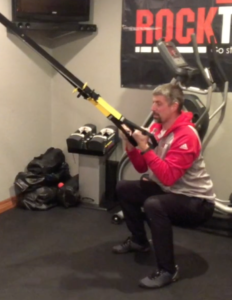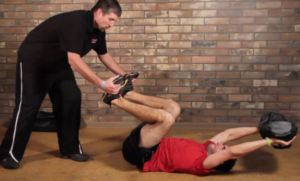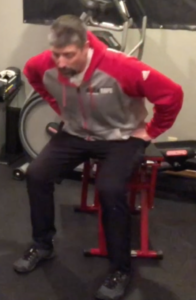by Mitch Hauschildt, MA, ATC, CSCS
The squat is widely accepted as a fundamental movement that is needed for all activities, including Activities of Daily Living (ADLs). It is obviously needed for athletic movements in order run, jump, plant and cut. But, it is also needed for basic things like sitting on a toilet. Being able to squat, at least to a certain degree, is important for all people.
One problem with the squat is that it is a very complex movement pattern. It requires full triple flexion of the lower body along with full extension of the upper half at the same time. This is a huge challenge for the brain and neurological system. Not to mention we need mobility at the ankles, hips, thoracic spine and shoulder, as well as stability at the foot, knee, trunk and shoulder complex.
One thing that I have found over the years is that most people who don’t squat well don’t typically have huge mobility deficits. I can’t tell you how many times I hear from coaches that someone can’t squat because their hips or ankles are tight. That may be true, but I find that many times, when they are closely evaluated, they don’t have a gross restriction that can explain why their squat looks so bad. In those cases, the faulty squat can only be attributed to a poor motor pattern. They have the ability to do it, they just don’t know how to squat.
In this case, it is important that we retrain the movement pattern. The goal is to get out of the poor default pattern and get to a more advantageous pattern. We need to distract the brain away from what it thinks is right and get to what is actually right.
One corrective strategy that Gray Cook talks about is reverse patterning. Its the idea that if a pattern is faulty, try doing it in reverse and it will likely get better. When you think about the squat, it makes perfect sense. The first time we we squat as an infant, we do it from the bottom up. We crawl over to an table or chair and then get to our feet and pull ourselves up to standing position. If we learn to do this for the first time from the bottom up, why then do we usually try to fix it from the top down? It just doesn’t make sense.
When correcting a squat, I have a few movements that serve me well.
- Lying reverse squat: This is great for helping people to understand that they need to create stability through the entire movement, even the descent. Start them on their back and have them actively pull themselves into the deep squat position while you manually resist them with your hands on the tops of their feet. Their goal is to achieve a deep squat position with their back on the floor. The focus is on the pull action into the deep flexed position.
- Box bottom up squat: I like this technique for introducing the squat movement after surgery or a major injury. Its easy and safe. Have them sit on the box. I don’t care how they
 get there. Just sit. Then, even up the feet, get toes straight ahead, lean forward until your center of gravity is over your feet and stand up. You will be surprised at how good people look standing up off of the box. Groove this pattern 10-20 times and then you can start working it from the top down.
get there. Just sit. Then, even up the feet, get toes straight ahead, lean forward until your center of gravity is over your feet and stand up. You will be surprised at how good people look standing up off of the box. Groove this pattern 10-20 times and then you can start working it from the top down. - TRX bottom up squat: This variation is effective for helping people explore a deep range of motion where most people haven’t been in a long, long time. Again, I don’t care how they get to the bottom. Once they get there, move around a little bit until you get to the bottom of a good squat. Pull yourself over top of your feet and raise your hips until you get to a neutral spine. From there, pause for a second and really feel what a deep squat feels like. Once you get comfortable in this position from the bottom up, then you can start grooving the pattern from the top down.
For a better understanding of these movements, see the video below.
Feel free to vary these movements to fit the needs of your patient or facility, but the concept of reverse patterning the squat is an effective one that you should have in your clinical toolbox.


Another excellent concept and video.
Thank you, Mitch!
Thanks Mitch this is going to help me with my client who’s having issues with getting low